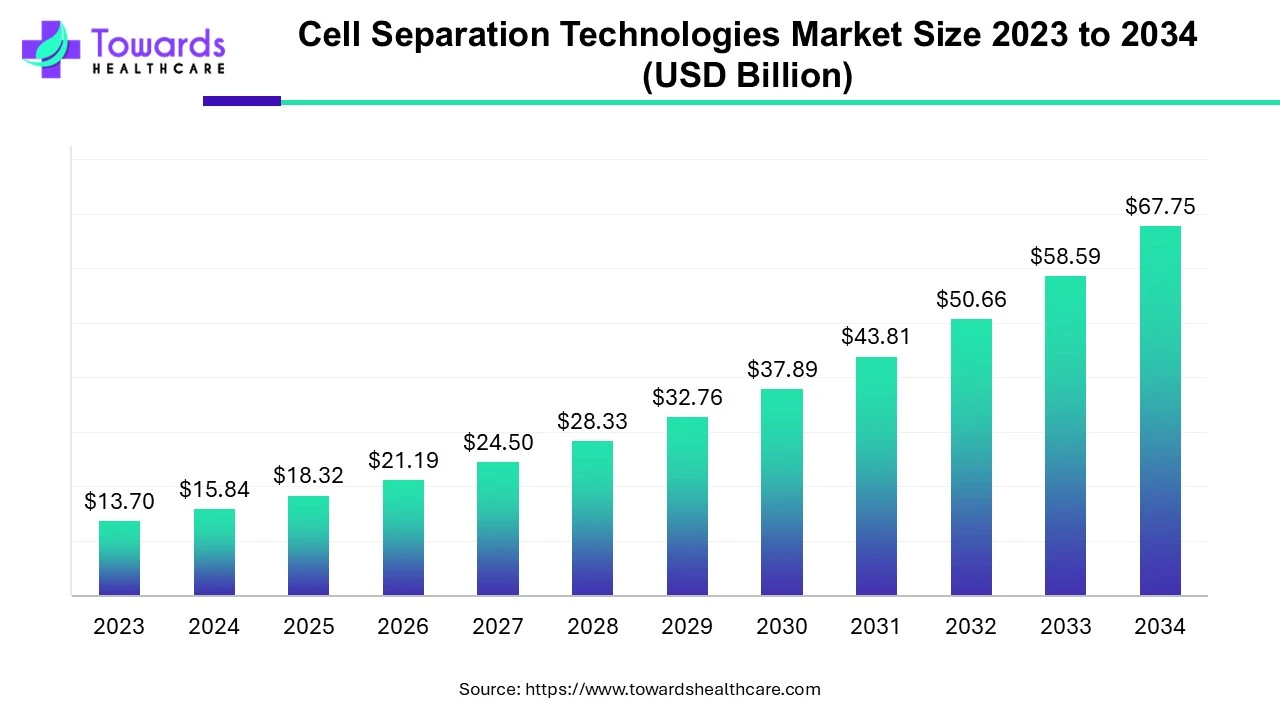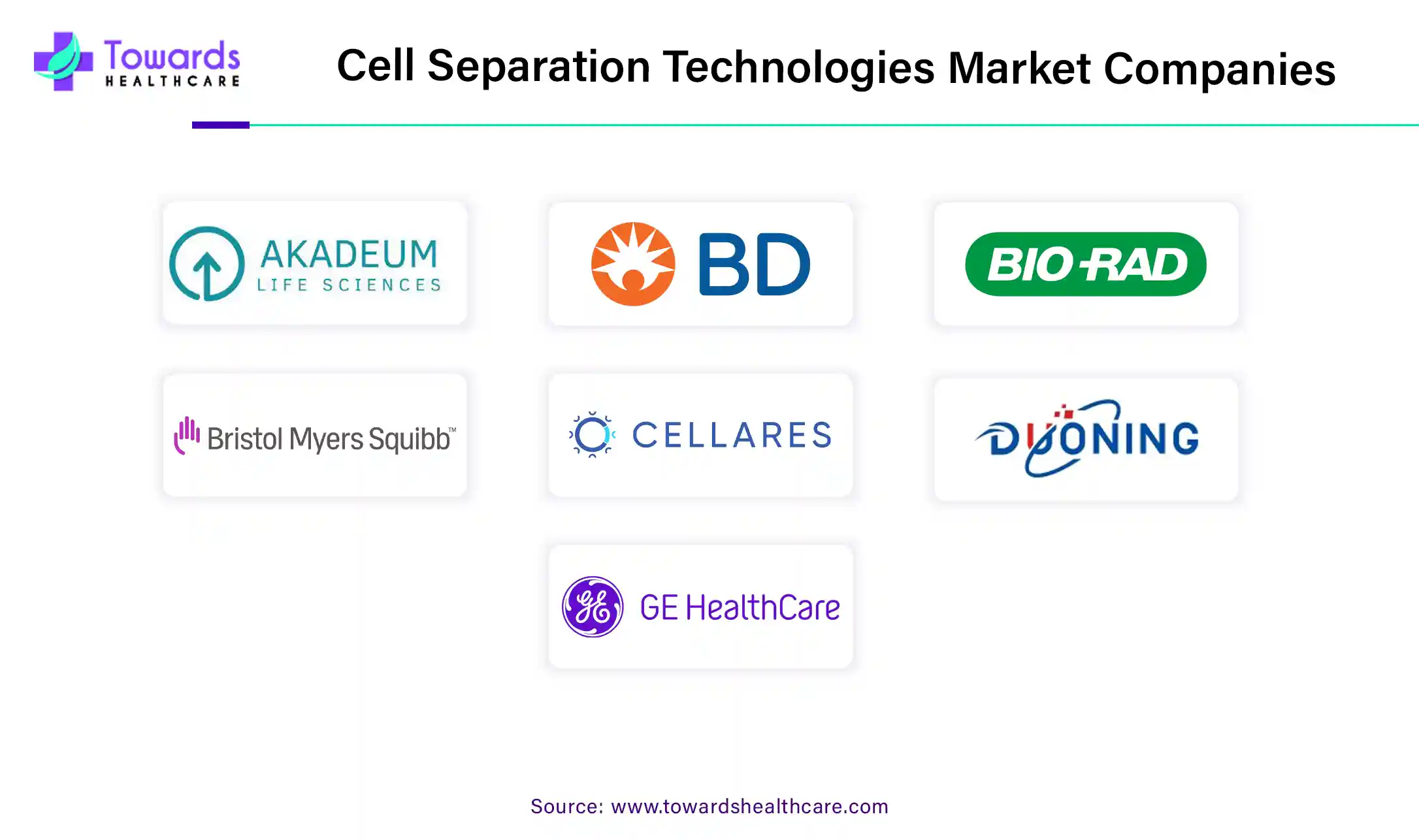April 2025

The global cell separation technologies market size is calculated at USD 15.84 billion in 2024, grew to USD 18.32 billion in 2025, and is projected to reach around USD 67.75 billion by 2034. The market is expanding at a CAGR of 15.64% between 2024 and 2034. Technological advancements, rising demand for immunotherapy and regenerative medicine, and growing research and development drive the market.

Cell separation is a process of isolating one or more specific cell samples from a heterogeneous mixture. Cells are isolated to conduct molecular analysis of a single cell type, increase the sensitivity of analytical models, study in vitro effects of drugs on cell population, and for disease modeling and cell therapy research applications. Cells are separated using numerous traditional technologies such as fluorescence-activated cell sorting (FACS), density gradient centrifugation, field flow fractionation (FFF), dielectrophoresis (DEP), magnet-activated cell sorting (MACS), pre-plating, and conditioned expansion media. Some common characteristics considered when isolating cells include cell size, density, shape, and surface protein expression.
The rising incidences of chronic disorders and the inability of potential small molecules to treat them have led to the discovery of cell therapy products. The growing demand for stem cell products for numerous applications boosts the market. Moreover, technological advancements result in the latest innovations in cell separation technologies. Favorable government policies and increasing investments in biotechnology augment the cell separation technologies market.
Artificial intelligence (AI) can revolutionize the complete process of cell separation technologies. It can automate the cell isolation technique, thereby streamlining the process and enhancing productivity and reproducibility. AI can enable the recognition of specific cell types, including pluripotent stem cells, high-producer cells, and immune cells, enhancing versatility and accuracy. It can also optimize the process efficiency of cell separation technologies. AI and machine learning (ML) algorithms can aid scientists in rapidly selecting suitable separation techniques. Hence, this technology is a major advancement in cell sorting capabilities and has the potential to enhance clinical practice, medicines, and personalized therapy.
For instance,
Growing Demand for Cell Therapy Products: Cell therapy is a promising, rapidly evolving field to transform treatment against various diseases with significant unmet needs. Cell therapies are either stem cell-based or non-stem cell-based. Stem cells are unspecialized, self-renewable cells that can differentiate into any cell type. Non-stem cells include fibroblasts, chondrocytes, pancreatic islet cells, and immune cells such as T cells dendritic cells, and natural killer cells. Cell therapy can treat a variety of disorders including cancer, autoimmune diseases, and infectious diseases. The increasing investments and favorable government policies to support cell therapy research and commercialization potentiate its demand. The cell and gene therapy global funding was $5.9 billion in 2023, a 38% increase from 2022. Different government agencies have facilitated the establishment of state-of-the-art infrastructure for basic and clinical cell therapy research.
High Cost: The major challenge of the cell separation technologies market is the high cost of the process. The cost of kits and complex machinery for cell separation technologies requires huge investment. The average cost of a cell separation kit ranges from $100 to $800, while the average cost of complex machinery ranges from $80,000 to $500,000. The high cost limits the affordability of several organizations in the LMICs.
Latest Innovations: The rising demand for cell therapy products and technological advancements drive the latest innovations in cell separation technologies. New advancements overcome the challenges of conventional cell separation techniques. Several researchers are investigating emerging novel methods. The under-developed novel methods include the systematic evolution of ligands by exponential enrichment (SELEX), improved aqueous two-phase system, and various types of microfluidic platforms. Novel methods are developed to achieve high purity in stem cell separation, simplicity of the separation process, and mass production of samples. The rising demand for lab-on-a-chip technologies to create microminiaturized devices increases the demand for microfluidics. It consumes less sample and reagent and requires less operator handling. In addition, researchers are investigating methods to increase flow rates and increase single-device surface area for microfluidics.
By product, the consumables segment dominated the cell separation technologies market in 2023. Consumables for cell separation technologies include kits, several reagents, and columns. These consumables are required frequently to perform numerous experiments. The growing research and development in many government and private organizations increases the demand for consumables. In addition, they are affordable compared to cell separation instruments.
By product, the instruments segment is expected to grow fastest in the market during the forecast period. Instruments are the primary requirement for performing cell separation procedures. The rapidly growing demand for cell therapy encourages research organizations and companies to install cell separation instruments. Technological advancements integrating full automation, thereby eliminating manual errors also boost the segment’s growth.
By technology, the surface markers separation segment held a dominant presence in the cell separation technologies market in 2023. Cell surface markers are proteins and carbohydrates that are attached to the cellular membrane and can distinguish cell types from one another. The separation of cells based on surface markers is done using flow cytometry. Flow cytometry is a technique used to measure cell characteristics. However, the machine is modified to enable cell separation through fluorescence components. The technique is called Fluorescence-activated cell sorting (FACS). The high specificity, purity, and throughput of the technique make it a preferable choice.
By technology, the gradient centrifugation segment is anticipated to grow with the highest CAGR in the market during the studied years. The gradient centrifugation technique involves isolating based on the cells’ size and density. This method is widely preferred due to its large processing ability and ease of commercialization. Unlike FACS, it is an inexpensive cell separation technique.
By application, the oncology research segment led the global cell separation technologies market in 2023. The rising prevalence of cancer and the increasing need for cell therapy for cancer patients augment the segment’s growth. Approximately 20 million new cancer cases globally were reported in 2022. Separating and detecting circulating tumor cells (CTC) is one of the emerging cancer research fields for early cancer diagnosis and prognosis. The common technologies used to separate these cells utilize size-based, immunoaffinity-based, and density-based methods. The increasing investments and collaborations for oncology research boost the segment’s growth.
By application, the stem cell research segment is projected to expand rapidly in the market in the coming years. The growing demand for stem cells to treat numerous diseases like cancer, autoimmune disorders, neurological disorders, and hematological disorders drives the segment’s growth. Booming stem cell research for extended applications, novel developments due to technological advancements, and new product launches also potentiate the segment’s growth. The US FDA approved 7 new cell and gene therapy products in 2023.
By end-user, the biotechnology & biopharmaceutical companies segment held the largest share in the cell separation technologies market in 2023. The segment’s growth is attributed to suitable infrastructure, the presence of trained professionals to conduct research using advanced technologies, and the availability of capital investment. The increasing number of biotechnology and biopharmaceutical startups, especially in developing countries augment the segment’s growth.
By end-user, the cell banks segment is predicted to witness the fastest growth in the market over the forecast period. Cell banks are facilities that maintain and preserve cells of specific genomes for future therapeutic purposes. They provide a reliable source of cells for use in laboratory experiments, drug discovery, clinical testing, etc. Suitable research and storage facilities for cells promote the segment’s growth.
North America dominated the global cell separation technologies market in 2023. Technological advancements, the presence of key players, and favorable government policies drive the market. The Board of the California Institute for Regenerative Medicine (CIRM) recently approved the funding of $89 million for stem cell and gene therapy research. C3i Center Inc., a leading contract manufacturing organization in Canada for cell and gene therapies, has built a business model for funding $20 million per year over the next 5 years.
The funding will be used for the creation of large-scale facilities for domestic production and to help Canada secure a place in the potential cell and gene therapy market. The Canadian Government also announced an investment of $171.6 million for five science and research organizations across Ottawa. Out of which, $48.5 million was invested in the Stem Cell Network (SCN).
Asia-Pacific is projected to host the fastest-growing cell separation technologies market in the coming years. The rising geriatric population, increasing incidences of chronic disorders, increasing investments & collaborations, and growing research and development drive the market. The Chinese government develops laws, policies, and regulations for cellular therapies. China has been exploring regulatory strategies for cell therapies that are suitable for the domestic situation.
Local production and government investment also support the market. In April 2024, the President of India, Smt. Droupadi Murmu unveiled India’s first home-grown gene therapy for cancer at IIT Bombay. Hence, the Indian government actively encourages indigenous production. Government initiatives like “Make in India” and “Atmanirbhar Bharat” promote the development of cell therapy products within India at an affordable cost.

Xavier De Mollerat Du Jeu, Senior Director of Research and Development, Thermo Fisher Scientific commented that manual processes can reduce scalability and accessibility due to increased demand for cell therapies for patients. Hence the company collaborated with Multiply Labs to automate cell expansion and separation in cell therapy manufacturing. He also added that the company aims to bring incubator partnerships to the next level to deliver a fully automated GMP product and engineer the automation of their latest-generation closed system centrifuge.
By Product
By Technology
By Application
By End-User
By Region
April 2025
April 2025
April 2025
April 2025